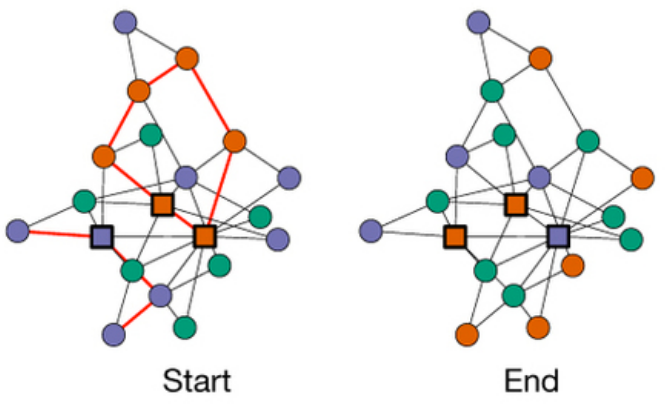When AI improves human performance instead of taking over
May 22, 2017

The game results show that placing slightly “noisy” bots in a central location (high-degree nodes) improves human coordination by reducing same-color neighbor nodes (the goal of the game). Square nodes show the bots and round nodes show human players; thick red lines show color conflicts, which are reduced with bot participation (right). (credit: Hirokazu Shirado and Nicholas A. Christakis/Nature)
It’s not about artificial intelligence (AI) taking over — it’s about AI improving human performance, a new study by Yale University researchers has shown.
“Much of the current conversation about artificial intelligence has to do with whether AI is a substitute for human beings. We believe the conversation should be about AI as a complement to human beings,” said Nicholas Christakis, Yale University co-director of the Yale Institute for Network Science (YINS) and senior author of a study by Yale Institute for Network Science.*
AI doesn’t even have to be super-sophisticated to make a difference in people’s lives; even “dumb AI” can help human groups, based on the study, which appears in the May 18, 2017 edition of the journal Nature.
How bots can boost human performance
In a series of experiments using teams of human players and autonomous software agents (“bots”), the bots boosted the performance of human groups and the individual players, the researchers found.
The experiment design involved an online color-coordination game that required groups of people to coordinate their actions for a collective goal. The collective goal was for every node to have a color different than all of its neighbor nodes. The subjects were paid a US$2 show-up fee and a declining bonus of up to US$3 depending on the speed of reaching a global solution to the coordination problem (in which every player in a group had chosen a different color from their connected neighbors). When they did not reach a global solution within 5 min, the game was stopped and the subjects earned no bonus.
The human players also interacted with anonymous bots that were programmed with three levels of behavioral randomness — meaning the AI bots sometimes deliberately made mistakes (introduced “noise”). In addition, sometimes the bots were placed in different parts of the social network to try different strategies.
The result: The bots reduced the median time for groups to solve problems by 55.6%. The experiment also showed a cascade effect: People whose performance improved when working with the bots then influenced other human players to raise their game. More than 4,000 people participated in the experiment, which used Yale-developed software called breadboard.
The findings have implications for a variety of situations in which people interact with AI technology, according to the researchers. Examples include human drivers who share roadways with autonomous cars and operations in which human soldiers work in tandem with AI.
“There are many ways in which the future is going to be like this,” Christakis said. “The bots can help humans to help themselves.”
Practical business AI tools
One example: Salesforce CEO Marc Benioff uses a bot called Einstein to help him run his company, Business Intelligence reported Thursday (May 18, 2017).
“Powered by advanced machine learning, deep learning, predictive analytics, natural language processing and smart data discovery, Einstein’s models will be automatically customised for every single customer,” according to the Salesforce blog. “It will learn, self-tune and get smarter with every interaction and additional piece of data. And most importantly, Einstein’s intelligence will be embedded within the context of business, automatically discovering relevant insights, predicting future behavior, proactively recommending best next actions and even automating tasks.”
Benioff says he also uses a version called Einstein Guidance for forecasting and modeling. It even helps end internal politics at executive meetings, calling out under-performing executives.
“AI is the next platform. All future apps for all companies will be built on AI,” Benioff predicts.
* Christakis is a professor of sociology, ecology & evolutionary biology, biomedical engineering, and medicine at Yale. Grants from the Robert Wood Johnson Foundation and the National Institute of Social Sciences supported the research.
Abstract of Locally noisy autonomous agents improve global human coordination in network experiments
Coordination in groups faces a sub-optimization problem and theory suggests that some randomness may help to achieve global optima. Here we performed experiments involving a networked colour coordination game in which groups of humans interacted with autonomous software agents (known as bots). Subjects (n = 4,000) were embedded in networks (n = 230) of 20 nodes, to which we sometimes added 3 bots. The bots were programmed with varying levels of behavioural randomness and different geodesic locations. We show that bots acting with small levels of random noise and placed in central locations meaningfully improve the collective performance of human groups, accelerating the median solution time by 55.6%. This is especially the case when the coordination problem is hard. Behavioural randomness worked not only by making the task of humans to whom the bots were connected easier, but also by affecting the gameplay of the humans among themselves and hence creating further cascades of benefit in global coordination in these heterogeneous systems.